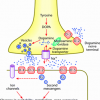Has anyone recieved any noticeable benefit to taking both Piracetam and Noopept in conjunction?

Piracetam + Noopept = Redundant?
#1
Posted 14 March 2014 - 07:58 AM
Has anyone recieved any noticeable benefit to taking both Piracetam and Noopept in conjunction?
#2
Posted 15 March 2014 - 08:45 AM
1. Unlike Piracetam, Noopept is not a racetam because it lacks a "pyrrolidone nucleus". (Loscher & Richter, 2000)
2. Piracetam binds to the Glu2 and Glu3 subunits of the AMPA receptors. (Ahmed & Oswald, 2010) -On a totally irrelevant note, while citing this, I noticed that GluR2-GluR3 heteromeric receptors replace the GluR1 containing receptors in an activity-independent manner in the constitutive pathway [47][48] And, may be responsible for the maintenance of new memories and replacement of damaged receptors and sustaining changes resulting from the regulated pathway. [no citation given on wiki unclear the accuracy of this claim] Anyway, while zoning off in class I was reading a book talking about the constitutive pathway being the other main pathway (the other being exocytosis) that a eukaryotic cell can release whats in its vesicles. So, if someone could explain the role of Piracetam in the constitutive pathway that may help us better understand how and why it might do some of the things it does. From what I read, it seems the constitutive pathway is vesicles that carry lipid and protein membranes rather than neurotransmitters.
-another off topic note, I see aniracetam and piracetam are positive allosteric modulators. So, does that mean they might share some of the antidepressant effects of the CX- series and arguably sunifiram?-
3. Another difference is that Piracetam can increase membrane fluidity however, this may not occur in healthy brains. (Muller WE Et. Al., 1997) (Eckert GP Et. Al., 1999)
4. Unlike Piracetam, Noopept may work by acting as a prodrug for the biological molecule it was engineered after Cycloprolylglycine. (Gudasheva TA Et Al., 1997)
5. Noopept may have a antianxiety effect by increasing spontaneous inhibitory post synaptic currants amplitude and frequency in hippocampal slices. (Kondratenko Et Al, 2010) Especially considering the high amount of benzodiazepine receptors in the hippocampus (Fuxe K et al, 1981)
#3
Posted 16 March 2014 - 01:14 AM
#4
Posted 16 March 2014 - 03:28 AM
A example could be like lunesta, sonata, and ambien are like benzos but are not benzos because they lack the benzene ring needed to meet that classification despite having extremely similar properties to benzos.
-racetam is a classification with requirements based on the structure of the chemical
however, -racetam is often used to mean memory boosting or piracetam-like in common language.
It is like how "steroid is a type of organic compound that contains a characteristic arrangement of four cycloalkane rings that are joined to each other."(wiki) in chemistry however, in media and casual discussion steroid is often used to mean "performance enhancing drug"
So, while clenbuterol is able to increase the muscle mass and decrease to fatty mass of an organism. Since it lacks four cycloalkane rings it technically is not a steroid despite being a performance enhancing drug.
#5
Posted 05 June 2014 - 01:34 AM
It is easy to think Noopept was a Racetam. Actually, I only found out it wasn't well after months of taking it. The reason for the confusion is that piracetam is used to estimate the potency of noopept in many many papers and piracetam is also the activity control. And, the dependent variables measured like memory etc. are often the same for both compounds.
A example could be like lunesta, sonata, and ambien are like benzos but are not benzos because they lack the benzene ring needed to meet that classification despite having extremely similar properties to benzos.
-racetam is a classification with requirements based on the structure of the chemical
however, -racetam is often used to mean memory boosting or piracetam-like in common language.
It is like how "steroid is a type of organic compound that contains a characteristic arrangement of four cycloalkane rings that are joined to each other."(wiki) in chemistry however, in media and casual discussion steroid is often used to mean "performance enhancing drug"
So, while clenbuterol is able to increase the muscle mass and decrease to fatty mass of an organism. Since it lacks four cycloalkane rings it technically is not a steroid despite being a performance enhancing drug.
Another example - if your going to benzodiazepines as an example - is the Thienodiazepine class. The Z Drugs or Non-Benzodiazpines (great nomenclature eh?) are very different in effect despite binding to the BZD receptor, and technically being subtituded diazepines on the GABA G-Protein Complex. No ones ever driven off a cliff, or woke up eating cold hotdogs out of the fridge thinking, what the hell am I doing (sleep walking - all the negative, potentially embarassing and life threatening side effects of the Z Drug Class - that Sonata, Lunesta and Ambien belong to) when taking Valium, Klonopin, Xanax or any of the commonly prescribed benzodiazepines (hypnotic sedatative IE - Restroil/Temazepam, Nitrazepam/Mogadon, etc or just plain anxiolytic ones like I just listed). The Z Drugs are all hypnotic sedatives - and the BZD site named after Benzodiazpines - they may of once been touted as the replacement for benzos but after using them myself - and seeing all the other people using them (and hearing the horror stories) - you can tell that Benzodiazpines efficacy and safety profile is much much higher.
"There are three primary groups of Z drugs, all of which can be labeled non-benzodiazepines:
Imidazopyridines -- zolpidem (Ambien, Ambien CR, Intermezzo, Stilnox)
Cyclopyrrolones -- zopiclone (Imovane, Zimovane, Imrest), eszopiclone (Lunesta)
Pyrazolopyrimidines -- zaleplon (Sonata, Starnoc)
All of these groups are believed to modulate benzodiazepine specific subunit sites, as specific agonists of the GABA-A receptors.
It is thought that the primary mode of action utilized by Z drugs is selective, and carries a high affinity for the a1 hypnotic-inducing site on the benzodiazepine subunit within the GABA-A receptor."
Where - Benzodiazepines, and Thienodiazepines are non-selective - hitting the whole of the Benzodiazeapine (BZD) subunit with no specificity fo a site on the BZD receptor - within the GABA-A Receptor. They may share a pharmachore but that doesn't make them equal in terms of effects or efficacy.
Also note: "Non-Benozodiazpines (sometimes colloquially called the "Z-Drugs") are a class of psychoactive drugs that are very benzodiazepine-like in nature. Nonbenzodiazepines pharmacodynamics are almost entirely the same as benzodiazepine drugs and therefore employ similar benefits, side-effects, and risks. Nonbenzodiazepines, however, have dissimilar or entirely different chemical structures and, therefore, are unrelated to benzodiazepines on a molecular level."
"Five types of Benzodiazepines
2-keto compounds:
chlordiazepoxide, clorazepate, diazepam, flurazepam, halazepam, prazepam, and others.
3-hydroxy compounds:
lorazepam, lormetazepam, oxazepam, temazepam
7-nitro compounds:
clonazepam, flunitrazepam, nimetazepam, nitrazepam
Triazolo compounds:
adinazolam, alprazolam, estazolam, triazolam
Imidazo compounds
climazolam, loprazolam, midazolam
Classical benzodiazepines (the 5 groups shown above) also bind to the peripheral benzodiazepine receptors.
Peripheral benzodiazepine receptors are present in peripheral nervous system tissues, glial cells, and to a lesser extent the central nervous system.
These peripheral receptors are not structurally related or coupled to GABA-A receptors. They modulate the immune system and are involved in the body response to injury.
Benzodiazepines also function as weak adenosine reuptake inhibitors. It has been suggested that some of their anticonvulsant, anxiolytic, and muscle relaxant effects may be in part mediated by this action.
To my knowledge - none of the non-benzodiazepines or Z Drugs - modulate your immune system in responce to injury, bind to any of the peripheral benzodiazepine receptors, or act as (albeit weak) adenosine reuptake inhibitors. If I remember correctly - there was one study that find paradoxically that diazepam (Valium, not all benzos) has an effect in increasing testosterone, either through release of LH, FSH, Testosterone or it inhibits the sex hormone binding globulin (SHBG)/sex-steriod-binding-hormone (SSBH) - which is the hormone found in the gonad - that makes the usable "free testosterone" into "bound testosterone" which the body cannot use unless the SHBG (which is the more common name for it) is inhibited. Which I found strange as benzos usually dull the libido versus raise it.
The Thienodiazepines are virtually indistiguishable to Benzodiazepines (except to the afficiando - who can tell they're more functional in lower doses than most benzodiazpines, but in a higher dose still produce the amnesia, hypnotic, skeletal muscle relaxant, anxiolytic -etc functions of a classical benzodiazepine) - where the Benzene group has been replaced with a Thiophene group.
These drugs include Etizolam (aka Etilaam-1 or Etilaam MD-1 if sublingual) and Brotizolam. This new class is easily oxidized, rapidly metabolized, and has a lower risk of accumulation, even after prolonged treatment. Etizolam has an anxiolytic action about 6 times greater than that of diazepam. Etizolam produces, especially at higher dosages, a reduction in time taken to fall asleep, an increase in total sleep time, and a reduction in the number of awakenings.
I'm not saying your chemistry is wrong, or that you're wrong at all haha. It's just that even looking at the IUPAC names for the Z Drugs and the fact that their nomeclature no matter the system/structure on the molecular level - looks nothing like that of a classical benzodiazepine, and the effect profile is vastly different, with far more dangerous side effects, and no reduced adverse side effects from classical benzodiazepines only gained adverse effects lol.
I personally think they're called Non-Benzodiazepines for a reason...its like the synethic cannabimimetics - they all bind to the CB1 and/or CB2 receptor sites (with diffferent binding affinities, and selectivity) but their structure and effects are almost nothing like that of traditional exogenous plant based cannabinoids such as delta-9-THC or CBD (or the analogs/semi-synthetic cannabinoids that retained true to the cannabinoid structure such as HU210) - all the fully synethic cannabimimetics are (much like you said noopept isnt a racetam because of the lacking pyrrilidone group) a far cry from true cannabinoids or even endogenous cannabinoids like anadamide - they're - Naphthoylindoles, Naphthylmethylindoles, Eicosanoids, Aminoalkylindoles, Naphthoylpyrroles, Benzoylindoles or Phenylacetylindoles (along with a plethora more I'm forgetting that all fall under an 'other' group of chemicals including the most recent generation, that are Indazole derivatives)
Classical cannabinoids are Dibenzopyrans.
Despite their chemical skeleton looking nothing like a classical cannabinoid on the molecular level - they still bind to the same sites, but produce drastically different effects (and remember Cannabis Sativa and Cannabis Indica contain over 470 phytocannabinoids - that all produce different effects some are agonists others are antagonists, some work on the Vannilioid and sigma receptors. Some are even inverse agonists, activity enhancers, allosteric modulators and cannabinoid reuptake inhibitors (while not natural - the best example is - Tylenol which is a prodrug for AM404 - an endogenous cannabinoid reuptake inhibitor.)
If something binds to a particular receptor site, the effects are not always predictable or the same, binding affinities and affinities for sub-types are different (either selective or unselective), and are they ligands, agonists, positive or negative allosteric modulators, antagonists, inverse agonists, reuptake inhibitors (selective or not), activity enhancers (such as a SSRE like Stablon), do they have other receptor affinities as well? All these things need to be taken into account. Before something can be considered to be equipotent or equally effective in the same manor, with no differing effects or new adverse side effects.
Just felt like working out my brain a bit with some chemistry haha, so I extropolated on the idea presented by mrd1 :-)
-AMKR
#6
Posted 05 June 2014 - 01:39 AM
But yes, to be more on topic - I most certainly have felt a synergy between Noopept and Piracetam (even more so with Sunifiram, Phenylpiracetam and a good Choline source, lately Ive been using Centrophenoxine and Choline Bitartate - cause the choline bitartate was only 5 bucks for a tub of 500 grams - which has lasted me over 2 years (and still hasnt expired haha). But if your going to use a stack like I just noted - lots of choline is needed, alpha GPC would probably be best to avoid headache from phenylpiracetam and sunifiram; and most certainly cycle off - as even on the second day I can tell the outstanding effects of the sunifiram and phenylpiracetam combined are diluted, tolerance builds fast and you don't wanna over do it. To keep that magic - make sure you use as needed or atleast cycle off on weekends or 3 days a week (from my experience atleast).
Also tagged with one or more of these keywords: piracetam, noopept, conjunction, together
2 user(s) are reading this topic
0 members, 2 guests, 0 anonymous users

















































